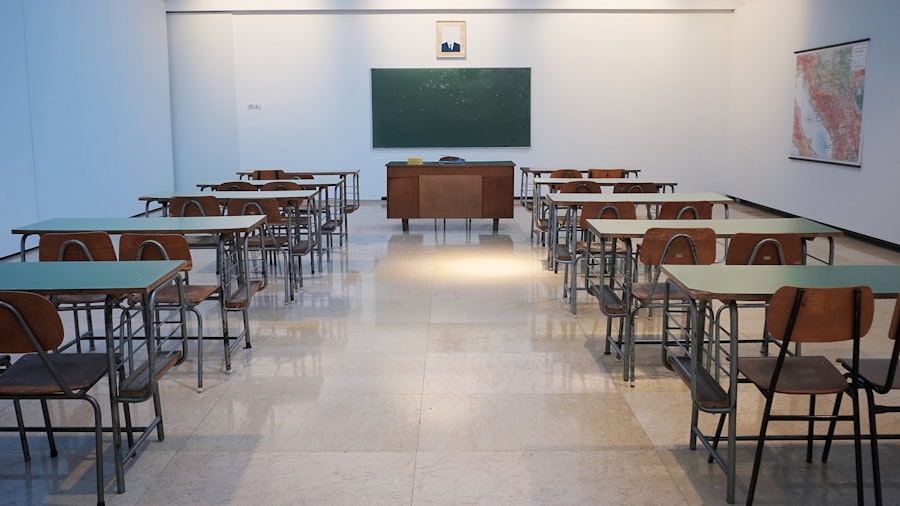As we delve into the realm of education, it becomes increasingly evident that attention difficulties are a significant barrier for many students. These challenges can manifest in various forms, including conditions such as Attention Deficit Hyperactivity Disorder (ADHD), autism spectrum disorders, and other learning disabilities. We recognize that students with attention difficulties often struggle to maintain focus, follow instructions, and engage with the learning material.
This can lead to frustration not only for the students themselves but also for educators and parents who are striving to support their learning journeys. Understanding the nuances of these difficulties is crucial for developing effective strategies that cater to the unique needs of each student. Moreover, we must acknowledge that attention difficulties are not merely a matter of willpower or motivation; they are rooted in complex neurological and psychological factors.
For instance, students with ADHD may experience challenges in executive functioning, which affects their ability to plan, organize, and execute tasks. Similarly, children on the autism spectrum may find it difficult to filter sensory information, leading to overwhelming distractions in a traditional classroom setting. By fostering a deeper understanding of these conditions, we can create a more inclusive educational environment that recognizes and accommodates the diverse needs of all learners.
The Role of Simulation in Education
In our quest to enhance educational outcomes for students with attention difficulties, we have increasingly turned to simulation as a powerful pedagogical tool. Simulation allows us to create immersive learning experiences that can engage students in ways that traditional methods may not. By simulating real-world scenarios or interactive environments, we can capture the attention of students who might otherwise struggle to remain focused during conventional lessons.
This approach not only makes learning more enjoyable but also provides opportunities for hands-on practice and application of skills in a safe and controlled setting. Furthermore, simulation can be particularly beneficial for students with special needs, as it allows us to tailor experiences to their individual learning styles and preferences. For instance, our COCO THINKS and COCO MOVES app harnesses the power of simulation to provide engaging educational content specifically designed for children with autism, ADHD, dyslexia, Down syndrome, and other learning challenges.
Through interactive activities and visual aids, we can help students develop essential skills while maintaining their interest and motivation. By integrating simulation into our educational practices, we are paving the way for more effective and inclusive learning experiences.
Types of Interventions for Students with Attention Difficulties

When it comes to addressing attention difficulties in students, a variety of interventions can be employed to support their learning needs. One common approach is the use of behavioral interventions, which focus on modifying specific behaviors through reinforcement strategies. For example, we might implement a reward system that encourages students to stay on task or complete assignments within a designated timeframe.
These interventions can be particularly effective when tailored to the individual preferences and motivations of each student, fostering a sense of ownership over their learning process. In addition to behavioral interventions, we also recognize the importance of cognitive strategies that help students develop self-regulation skills. Techniques such as mindfulness training or cognitive-behavioral therapy can empower students to manage their attention and emotions more effectively.
By teaching them how to identify distractions and implement coping strategies, we can equip them with valuable tools for navigating their educational experiences. Ultimately, a combination of behavioral and cognitive interventions can create a comprehensive support system that addresses the multifaceted nature of attention difficulties.
Benefits of Simulating Interventions for Students
The benefits of simulating interventions for students with attention difficulties are manifold and far-reaching. One of the most significant advantages is the ability to create engaging and interactive learning experiences that capture students’ attention. When we utilize simulation techniques, we can present information in a dynamic manner that resonates with students who may struggle with traditional instructional methods.
This heightened engagement not only enhances their understanding of the material but also fosters a sense of enjoyment in the learning process. Moreover, simulating interventions allows us to provide immediate feedback and reinforcement, which is crucial for students with attention difficulties. In our COCO THINKS and COCO MOVES app, for instance, we incorporate real-time feedback mechanisms that guide students through various tasks and activities.
This instant feedback helps them recognize their progress and areas for improvement, promoting a growth mindset and encouraging perseverance. By creating an environment where students feel supported and motivated, we can significantly enhance their overall learning outcomes.
Challenges in Simulating Interventions for Students
While the potential benefits of simulating interventions are clear, we must also acknowledge the challenges that come with this approach. One significant hurdle is ensuring that simulations are appropriately designed to meet the diverse needs of students with attention difficulties. It is essential that we create simulations that are not only engaging but also accessible and relevant to each student’s unique learning profile.
This requires careful consideration of factors such as sensory sensitivities, cognitive processing styles, and individual interests. Additionally, we face the challenge of integrating technology effectively into our educational practices. While simulation tools like our COCO THINKS and COCO MOVES app offer exciting possibilities, we must ensure that educators are adequately trained to utilize these resources effectively.
Without proper training and support, there is a risk that technology may become an additional source of frustration rather than a helpful tool for enhancing learning experiences. By addressing these challenges head-on, we can work towards creating a more seamless integration of simulated interventions into our educational frameworks.
Best Practices for Simulating Interventions for Students

To effectively support students with attention difficulties, it’s essential to implement best practices when designing and utilizing simulated interventions. By combining inclusive, engaging strategies with personalized approaches, we can create an environment where these students are empowered to succeed.
1. Involving Students in the Design Process
One of the most effective ways to ensure the success of simulated interventions is by involving students in the creation and customization of these experiences. By asking for their input and feedback on the types of simulations they find engaging, we can tailor the interventions to better meet their needs and preferences.
- Student-Centered Design: Engage students in discussions about their learning preferences, ensuring the simulations reflect what excites and motivates them.
- Feedback Loops: Collect feedback after each simulation session to refine and adjust the experience for better results, allowing students to feel heard and valued.
2. Utilizing Multi-Sensory Approaches
Students with attention difficulties often benefit from simulations that engage multiple sensory modalities. This multi-sensory approach taps into different learning styles, making it easier for students to focus and absorb information. Incorporating visual, auditory, and kinesthetic elements into the simulation helps create a richer, more stimulating experience.
- Visual Stimulation: Use colors, images, and visual aids that enhance focus and guide students through the activity.
- Auditory Cues: Incorporate sound effects, spoken instructions, or music to reinforce key concepts and maintain attention.
- Kinesthetic Interaction: Design hands-on activities or movement-based elements that allow students to physically engage with the content, reinforcing learning through action.
3. Providing Opportunities for Collaboration and Social Interaction
Simulated interventions should offer opportunities for students to collaborate and interact with their peers. Social interaction not only boosts engagement but also encourages teamwork and communication, which can be particularly beneficial for students with attention difficulties who may struggle with isolation.
- Group Work: Incorporate collaborative tasks that require students to work together to solve problems or complete activities.
- Peer Support: Allow students to share their insights and ideas with one another, promoting social learning and mutual support.
- Games and Challenges: Create group-based simulations that involve friendly competition or cooperative challenges, fostering a sense of community.
4. Breaking Down Tasks into Manageable Segments
Students with attention difficulties often find it challenging to stay focused on long, complex tasks. To address this, simulations should break down tasks into smaller, manageable chunks. This approach prevents overwhelm and allows students to experience success incrementally, which can help build their confidence and motivation.
- Step-by-Step Guidance: Provide clear, simple instructions for each step of the simulation, ensuring students understand what is expected.
- Frequent Breaks: Allow students to take short breaks to recharge, improving focus and minimizing frustration.
5. Incorporating Immediate Feedback and Rewards
Immediate feedback during simulations is essential for students with attention difficulties, as it helps them stay on track and make adjustments in real-time. Positive reinforcement, such as rewards or praise, can also motivate students to stay engaged and persist through challenges.
- Instant Feedback: Offer real-time feedback on students’ actions to guide their progress and correct mistakes.
- Gamification Elements: Use points, badges, or progress trackers to reward achievements, keeping students motivated to continue working through the simulation.
6. Promoting Flexibility and Adaptability
Simulated interventions should be flexible enough to accommodate the varying needs of students with attention difficulties. Different students may respond better to different types of simulations, so it’s important to offer a range of options and allow for adjustments based on individual needs.
- Personalized Learning Paths: Tailor simulations to fit the pace and difficulty level that works best for each student.
- Adaptive Tools: Utilize apps or platforms that allow for modifications in real-time, ensuring the experience remains effective and engaging as students progress.
The Impact of Simulated Interventions on Student Success
The impact of simulated interventions on student success cannot be overstated. As we implement these innovative approaches in our educational settings, we have observed significant improvements in student engagement, motivation, and overall academic performance. Students who previously struggled to maintain focus during traditional lessons often thrive in simulated environments where they can actively participate in their learning process.
This shift not only enhances their understanding of the material but also boosts their confidence as learners. Furthermore, simulated interventions have been shown to promote the development of essential skills beyond academic content knowledge. For instance, through interactive simulations, students can practice problem-solving, critical thinking, and social skills in realistic scenarios.
These experiences prepare them for real-world challenges they may encounter outside the classroom. As we continue to explore the potential of simulated interventions through tools like our COCO THINKS and COCO MOVES app, we remain committed to fostering holistic development for all students.
Future Directions in Simulating Interventions for Students with Attention Difficulties
Looking ahead, we envision a future where simulated interventions become an integral part of educational practices for students with attention difficulties. As technology continues to advance, we anticipate even more sophisticated simulation tools that can adapt to individual learners’ needs in real time. This personalization will allow us to create tailored experiences that respond dynamically to each student’s progress and challenges.
Moreover, we foresee increased collaboration between educators, researchers, and technology developers to ensure that simulated interventions are grounded in evidence-based practices. By sharing insights and best practices across disciplines, we can refine our approaches and maximize the impact of these interventions on student success. Ultimately, our goal is to create an inclusive educational landscape where all students—regardless of their attention difficulties—can thrive and reach their full potential through innovative simulation strategies like those offered by our COCO THINKS and COCO MOVES app.
For educators and parents seeking effective strategies to support students with attention difficulties, exploring various interventions can be crucial. An interesting related article discusses educational activities that can be beneficial for homework time after school, particularly for students who may struggle with maintaining focus. These activities are designed to engage students in a manner that aligns with their learning needs while also making homework a more enjoyable experience. You can read more about these strategies and ideas by visiting this article. It provides practical tips and activities that can be easily implemented to help students with attention difficulties succeed academically.




